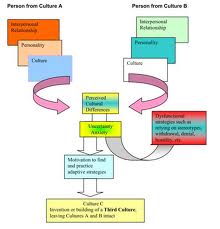The Best Souvenir: Intercultural Marriage and Partnership
This post is contributed by Deidra Razzaque, a SPS Featured Blogger.
———–
In 1782 the French began using the word souvenir to mean “the act of remembering.” Today there is varied opinion about souvenirs, those mementos we often bring back from our journeys.
But I like the idea of reviving the original meaning of souvenir when we think of intercultural marriage and partnership. Our intimate relationships are the embodiment of “the act of remembering” what is most important.
If your re-entry includes a life partner whose cultural background is different from yours, what are some things you can do to help your relationship thrive?

Obviously there are those things that keep any marriage or partnership healthy, including mutual respect, fun, romance, and the willingness to communicate even when the going gets rough. But intercultural relationships have added dimensions that can change what a great relationship formula looks like.
There are obvious differences such as language, foods, and traditions. And there are underlying beliefs that sometimes make intercultural relationships challenging.
Dugan Romero, who wrote Intercultural Marriage: Promises and Pitfalls, claims that “one of the biggest benefits of these [intercultural] marriages is the opportunity they provide for personal growth, and…we are more likely to grow in self-understanding by wrestling with differences than by relaxing into commonalities.”
I think intercultural relationships do help us grow in self-understanding, but they also move us far beyond thinking only about ourselves. I met my Costa Rican husband when I was there in the Peace Corps, and we’ve been together 14 years now.
Here are three things that have helped us weather challenges, grow in unexpected ways, and continue to find delight in one another:
1. Acknowledging Differing Worldviews
When Eddy and I first started dating, he would sometimes arrive late. Since most Costa Ricans I knew wouldn’t dream of arriving until seven if a meeting was scheduled for six, I told him that this seemed like a big cultural difference that would have been totally unacceptable where I came from.
But Eddy, who had lived in Costa Rica since he was a young child, would say that there were no such things as cultural differences. At the time he believed that all of our differences of opinion and action were a reflection of our families of origin.
Once we moved to Vermont, Eddy began noticing some things that made him re-think his view. For example, when he saw someone struggling to carry several packages, he would offer to help. Inevitably the person would say, “Oh, no, I’m fine. I’ve got it,” even as things were falling from his or her hands.
At first Eddy felt rebuffed and frustrated. But then we started to discuss how in the United States people are taught from an early age that independence is very important, while in Costa Rica people learn from an early age that they should help one another whenever possible.
A friend who is from Aruba, and whose partner is from the United States, says that one thing that makes an intercultural relationship different from one with someone from the same culture is that you are continually discovering cultural idiosyncrasies in your partner that are not unique to your partner.
Sometimes just knowing that there is a whole culture standing behind your spouse, believing that the group is more important than the individual, for example, can take the charge out of your own family argument. Knowing something about a culture gives you a little distance from your feelings. It can turn an argument between you and your spouse into a source of curiosity rather than letting it remain a sore spot of contention.
Geert Hofstede studied 100 cultures to compare their worldviews. His work was originally created for business use, but taking a look at this can also help you as an intercultural couple. Use his country comparison chart to see where your culture and your partner’s line up in six different areas, including what motivates people and how likely people are to act on their impulses.
2. Purposely Choosing the Life You Create Together
My friend Allison, who is from the United States and is married to a man from Ecuador, says that a successful intercultural relationship includes “immersing yourself to your partner’s culture, and vice-versa; talking about what you want personally and as a couple; and creating your own new relationship culture that draws from your mother cultures, but is independent and new and truly yours.”
Researchers Carley Dodd and Fred Casmir have created a model of that “independent, new and truly yours culture” that Allison refers to. They call it “Culture C,” a third culture that is born from two others.
Eddy and I often see this Culture C in our relationship when we make decisions about how we raise our children, explore our reasons and the results we’re hoping for, and compare our path to what other parents have chosen.
Obviously, our children’s needs, our own personalities, and how our families of origin raised us also play a role in those decisions. But it is interesting to see that often we’re doing things differently than the cultural norms in both of our home countries. I think of Culture A as one partner, Culture B as another, and Culture C as the intricate dance they do together.
But it is interesting to see that often we’re doing things differently than the cultural norms in both of our home countries. I think of Culture A as one partner, Culture B as another, and Culture C as the intricate dance they do together.
See the chart to the right, and think about how it applies to your own experience.
3. Letting a Shared Sense of Wonder Strengthen You as a Couple
What makes you feel enchanted by your partner’s culture?
For me, there are many things, and some are deceptively simple, like star fruits. Once, my husband and I stopped to eat at an outdoor café in Cahuita, Costa Rica. When I looked up, I realized that we were sitting underneath a carambola tree, which I had never seen before.
Watching the sun against bright green leaves, seeing the branches bursting with yellow fruit, and smelling the powerful scent of ylang-ylang trees down the road, I thought, “Now this is truly an exotic experience.” For my husband, the scene was so normal that he barely registered it, until he noticed my delight.
Years later, we went to an apple orchard in Vermont. Until then, Eddy had only seen Red Delicious apples shipped to Costa Rica for the Christmas holidays. He had assumed that apples grew along the ground, like squash. He had also thought that all apples were red. It was his turn to have a big grin on his face as we walked along the rows of lovely trees heavy with fruits of different colors and flavors.
For me, what brings us together across cultures is pure magic. When I decided to join the Peace Corps, I asked to go to any country on the two entire continents of Africa and Asia—that’s over 100 countries. But my recruiter called saying “Hey, there’s this program in Costa Rica that is looking for a very specific skill set. They want one person for this position, and it’s you. Please won’t you go?”
I thought about it for a while, and in the end something made me say yes. And there, waiting for me, was my husband and a whole life I would not have known otherwise. If I had made a different choice, my life today would be completely altered. Isn’t that wild? Out of the unknown, the different, the unexpected…we can find a home in one another. What a souvenir.
Are you in an intercultural partnership? What helps your relationship to thrive?
Photo credits here and here

